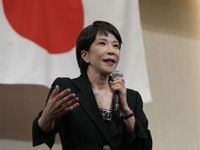Japan has made history. On October 21, 2025, the nation’s parliament elected Sanae Takaichi as its first female prime minister, propelling her into the global spotlight and marking a new chapter in Japanese politics. But while her victory shatters a long-standing glass ceiling, it also signals a sharp turn to the right for the country’s leadership—raising as many questions as it answers about the future direction of Asia’s second-largest economy.
Takaichi, a longtime member of the ruling Liberal Democratic Party (LDP), stepped into the role after her predecessor, Shigeru Ishiba, resigned in the wake of disastrous election results for the party. The LDP lost its majority in the lower house last year and suffered further setbacks in the July 2025 upper house elections, forcing the party into a fragile coalition with the right-wing Japan Innovation Party. This alliance, short of a majority in both houses, leaves Takaichi’s government vulnerable and reliant on cooperation from opposition groups to pass any meaningful legislation, according to AP.
“I’m determined to build a strong Japanese economy and protect Japan’s national interest with diplomacy and security,” Takaichi declared after her election, echoing her reputation as a security hawk and a protégé of the late former Prime Minister Shinzo Abe. Her focus on defense is timely: she’s preparing to host U.S. President Donald Trump for a major diplomatic visit from October 27 to 29, a meeting that could set the tone for Japan-U.S. relations in an increasingly tense Indo-Pacific region. Takaichi has called the Japan-U.S. alliance a “cornerstone” of Japanese diplomacy and stressed Japan’s indispensable role as a counterweight to China, as reported by TNND and AP.
Yet for all the headlines about her breaking barriers, Takaichi’s leadership is not a victory for progressive politics. Her political stance is firmly ultraconservative, with traditionalist views on women’s roles and society at large. She is an admirer of Margaret Thatcher but has consistently stonewalled measures to advance women’s rights. Despite pledging to increase the number of women in her Cabinet, she has appointed only two: Satsuki Katayama as finance minister and Kimi Onoda as economic security minister. Takaichi supports the imperial family’s male-only succession, opposes separate surnames for married couples, and is a staunch opponent of same-sex marriage. LGBTQ+ rights activist Soshi Matsuoka told AP, “The birth of Japan’s first female prime minister is epoch-making, but she casts a dark cloud over gender equality and sexual minority rights.”
Her approach to immigration is similarly hardline, mirroring right-wing populist movements worldwide. Takaichi emphasizes national identity and supports restrictive immigration policies—even as Japan faces a demographic crisis with a population decline stretching over 16 consecutive years and growing labor shortages. Critics, including Devdiscourse, warn that her policies may worsen Japan’s economic stasis by failing to address the urgent need for pragmatic immigration reforms.
These stances have not gone unnoticed, either at home or abroad. Takaichi’s regular visits to the controversial Yasukuni Shrine—a site seen by Beijing and Seoul as a symbol of unrepentant Japanese militarism—have drawn sharp criticism. In a bid to ease tensions, she sent a religious ornament to the shrine instead of visiting in person this year, but her nationalist credentials remain a source of concern for Japan’s neighbors. Chinese Foreign Ministry spokesperson Guo Jiakun urged Japan to “honor its political commitments on major issues including on history and Taiwan,” while South Korean President Lee Jae Myung congratulated Takaichi but also emphasized the importance of stable bilateral ties, especially as global uncertainty deepens. Lee expressed hope to meet Takaichi during the Asia-Pacific Economic Cooperation meetings later this month, according to AP and TNND.
European Commission President Ursula von der Leyen also weighed in, congratulating Takaichi and pledging to work closely on strengthening the EU-Japan partnership. “As Japan’s first female PM, you’re making history,” she wrote, as reported by AP. “I look forward to working closely together to take the unique EU-Japan partnership to the next level.”
Back in Japan, Takaichi faces a daunting to-do list. The LDP’s coalition is fragile, and the government’s minority status means any misstep could spell political disaster. The country has cycled through five prime ministers in as many years, eroding public trust in the political system. “Without political stability, we cannot achieve strong economic policies, diplomacy, security or anything,” Takaichi acknowledged in her first remarks as prime minister.
Her immediate priorities include addressing rising prices and compiling economic stimulus measures by late December to ease public frustration. But many observers are skeptical about her ability to enact meaningful change. As Devdiscourse noted, her conservative platform and coalition disputes may prevent her from tackling Japan’s most pressing issues, especially the demographic crisis and economic stagnation.
The symbolism of her election, however, is not lost on the world. With Takaichi’s ascent, Japan joins more than 80 nations that have had a woman serve as head of state or government since World War II, according to the Council on Foreign Relations. As of July 2025, 82 of the United Nations’ 193 member states—about 43%—have experienced female leadership. The trend extends far beyond northern Europe, with countries like Mexico, where Claudia Sheinbaum became president in 2024, demonstrating that women’s leadership is becoming increasingly commonplace worldwide, as highlighted by AP.
Public opinion in Japan is sharply divided. Some see Takaichi’s rise as a long-overdue breakthrough for women in a nation where they hold only a small fraction of parliamentary seats. “I really hope she serves for a long time, and that the political stagnation we’ve been seeing finally starts to move, and that things improve in Japan and in the eyes of the world,” said Takayuki Eguchi, a Tokyo resident who marked the occasion by collecting a special newspaper edition, according to AP.
Others, however, worry that her election represents a step backward for gender equality and minority rights. Takaichi’s critics point to her record of opposing reforms and her close ties to nationalist factions as evidence that her leadership may deepen social divides rather than heal them.
For now, Takaichi’s leadership is set to be tested almost immediately. Her scheduled meeting with President Trump looms large, and the world will be watching to see whether she can build the trust and diplomatic rapport needed to steer Japan through turbulent waters. “At first, I hope to develop relations of trust between the two leaders through candid exchange of views about the challenges that Japan and the United States face,” Takaichi said, as cited by TNND and AP.
Whether her government can deliver on the promises of economic revival, social stability, and international cooperation remains to be seen. But for better or worse, Sanae Takaichi’s election has already left an indelible mark on Japan’s political landscape and the world’s perception of what leadership looks like in the 21st century.



